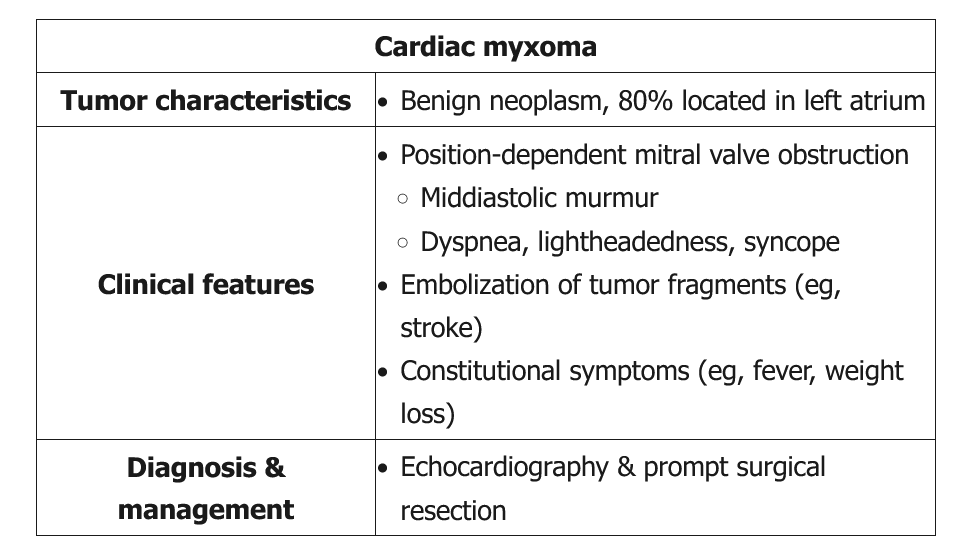left axial myxoma
- related: Cardiology

This patient's presentation with transient vision loss (amaurosis fugax), unintentional weight loss, and diastolic murmur is suggestive of cardiac myxoma. Myxomas are the most common benign primary cardiac tumors, with approximately 80% located in the left atrium.
Left atrial myxomas can cause obstruction of blood flow across the mitral valve, mimicking mitral valve disease and producing an early diastolic sound ("tumor plop"). Patients often have fatigue, cough, dyspnea, orthopnea, pulmonary edema, or hemoptysis. Left atrial tumors can also cause systemic embolization (eg, transient ischemic attack, stroke, splenic infarcts). About 50% of patients have constitutional symptoms (due to overproduction of interleukin-6) such as fever, weight loss, or Raynaud phenomenon.
Although transesophageal echocardiography (TEE) is the most sensitive test for diagnosis, transthoracic echocardiography is usually adequate. Once the diagnosis is established, prompt surgical resection is recommended to avoid complications of embolization and risk of sudden death.
Atrial myxomas are the most common primary cardiac tumors, with the majority occurring in the left atrium. The tumors are typically pedunculated with a stalk coming from the atrial septum, and can be extremely friable, sometimes leading to the release of tumor emboli into the systemic circulation. Some large tumors can present with signs and symptoms of mitral valve obstruction (causing a diastolic murmur and "tumor plop"), rapidly worsening heart failure, and new-onset atrial fibrillation. The diagnosis is confirmed by echocardiography (transesophageal preferred over transthoracic), and prompt surgical excision is typically indicated.
This patient has acute-onset pain, diminished pulses, and paleness and coolness of the left foot, which are consistent with acute arterial occlusion. Acute arterial occlusion can occur due to an embolus from a proximal source, acute thrombosis of an atherosclerotic plaque, or direct trauma to the involved artery. The sudden onset of symptoms in this young, previously asymptomatic patient is most consistent with an embolus. Most emboli originate from a cardiac source, and may occur due to atrial fibrillation, severe ventricular dysfunction, endocarditis, valvular disease, atrial myxoma, or a prosthetic valve. This patient has a regular heart rhythm with an apical diastolic murmur, making left atrial myxoma the most likely cause of the embolus.